Gateways to Great Instruction: Why HQIM Belongs in Educator Preparation Programs
July 16, 2025

Great teachers deserve great instructional support and resources that not only define what they teach, but how. That approach is malleable, dependent on any given school year and the student needs that come with it. High Quality Instructional Materials (HQIM) help teachers deliver instruction that challenges and engages students, but knowing how to navigate and implement HQIM in a way that meets students' specific needs is half the battle for new teachers.
This gap in the professional pipeline is not something that institutions can afford to ignore. Many new educators enter their classrooms underprepared in how to effectively use HQIM, leading to frustration, a lack of confidence, and the need for support that may not be accessible. NIET has recognized the gap from educator preparation to practice when it comes to HQIM, and is working statewide in Arkansas to ensure understanding of HQIM implementation becomes the common denominator both in classes where aspiring teachers learn, and the classes they go on to teach.
NIET has partnered with the Walton Family Foundation in Arkansas since Spring 2025 to expose aspiring teachers to HQIM before entering the classroom. This partnership has engaged more than a dozen Educator Preparation Programs (EPPs) statewide to equip aspiring teachers with the foundations of HQIM, setting them up for success in alignment with state standards.
The core reason NIET’s EPP sessions on HQIM are so effective in reaching aspiring teachers is that the work doesn’t start with the aspiring teachers - it begins with the faculty and staff who are preparing them. Building the capacity of education faculty, university supervisors, and teacher preparation administrators to deeply understand HQIM and adapt its use to meet diverse student needs is essential. Their ability to model and support effective HQIM practices ultimately determines how well aspiring teachers learn to implement high-quality instruction in their own classrooms.
Growing a Go-first Mentality, Program-wide
This comprehensive approach to navigating HQIM is specifically designed to put EPPs in the driver’s seat of their instruction and delivery of this content, rather than NIET. By working in tandem with each EPP and promoting a ‘go-first’ mentality within the faculty and administration, these strategies are anchored in standards, HQIM, and evidence of student learning. Interesting parallels became clear along the way, including similarities between EPPs with apprenticeship programs and those with non-traditional pathways, where educators were receiving their Master's in Education while already teaching in the classroom. Both of these EPP approaches include the job-embedded element, which provides connections and comparisons to how they best applied HQIM instruction into their systems.
A ‘go-first’ mindset begins with building EPP’s confidence in modeling HQIM practices themselves before embedding them into aspiring teacher coursework, a callback to the famous quote, “You can’t teach what you don’t know.” Participants’ work mirrors NIET’s Teacher Learning Progression on Curriculum by supporting the embedding of HQIM in coursework and fieldwork at every level - from knowing where to find resources on the state website, to navigating specific student needs while maintaining curriculum fidelity.
“This was a great awareness and skill development opportunity,” one associate professor of education participant shared. “I am doing more in two courses this semester as a result of the training provided.”
Hands-on HQIM
Another transformational factor in these sessions is that participants don’t use generic or unrelated samples or sources throughout their learning. Instead, they are engaging with their own course syllabi and materials to further understand HQIM implementation in instruction and identify areas where minor changes within their own systems can lead to significant improvements in teacher preparation and instructional impact. Hands-on workshops, which are offered along core trainings, include mapping syllabi and coursework to state standards, auditing assessments, and observing HQIM in action. By the time participants had completed their trainings, more than 90% of survey respondents shared that it helped them gain new and applicable knowledge about HQIM implementation and feel more confident in their roles to prepare their aspiring teachers.
"I loved learning about the five stages of the learning progression on HQIM. This will help me support instructional facilitators and teachers better,” one participant said of the training.
These sessions further deepen alignment and relevancy because they are designed with existing state tools in mind, such as Arkansas’ TESS rubric for aspiring teachers and HQIM teacher competencies, bridging the gap between concept to practice in real-time. By grounding the learning in these familiar frameworks, participants can easily connect expectations for aspiring teachers with concrete instructional strategies and curriculum decisions within their own programs.
Sustaining Gateways to Great Instruction
Ultimately, these sessions prepare EPPs to leverage the new generation of aspiring teachers as they enter a workforce that is implementing HQIM, which can either pose as an effective instructional tool or a frustrating barrier, depending on how well teachers know how to use them effectively. Reinforcing and elevating the educational gateways into the profession, both traditional and non-traditional EPPs, is the first step toward aligning teacher preparation and academic standards, sustaining excellent educational practice in Arkansas, and cultivating the student achievement that comes with great instruction.
NIET’s HQIM sessions for EPPs will continue through Fall 2025 and are open to any Educator Preparation Programs in Arkansas seeking to embed HQIM instruction into their curriculum to benefit aspiring educators. Visit NIET’s state partnership page for more information on this work.
Beyond state borders, NIET continues to explore HQIM support with EPPs and K-12 schools nationwide, including work in Louisiana. By aligning educator preparation with real-world instructional expectations and standards, this model offers a scalable path to close the HQIM implementation gap that can loom before new teachers, ultimately improving teaching quality and achievement nationwide.
Interested in learning more about this support, or what else NIET has to offer your school and district? Contact us to connect.